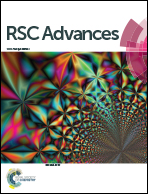CuFe2O4 nanoparticles: a magnetically recoverable and reusable catalyst for the synthesis of quinoline and quinazoline derivatives in aqueous media
Abstract
The synthesis of quinoline and quinazoline derivatives is attempted using magnetically separable and reusable CuFe2O4 nanoparticles in aqueous media. Nano sized CuFe2O4 was prepared by the thermal decomposition of Cu(NO3)2 and Fe(NO3)3 in water in the presence of sodium hydroxide and confirmed by X-ray diffraction patterns (XRD), scanning electron microscopy images (SEM) and transmission electron microscopy (TEM). The catalytic activity of CuFe2O4 nanoparticles was evaluated in aqueous media and the results show its applicability as a green, reusable and promising catalyst in organic synthesis.


 Please wait while we load your content...
Please wait while we load your content...